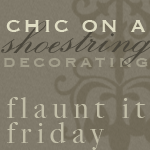Okay, well. After my little *fail* last night, I also had a win! I used glaze for the first time! For those of you in the know, bear with me, but this is all very new and exciting to me.
Ever wonder how furniture gets that super aged patina? Well, this is how!
 |
| Before Glaze |
 |
| After Glaze |
Not that it looked bad without the glaze, I just like it to get into the nooks and give another layer of depth and dimension. The glazed chair looks a little harsher here. I've since toned it down a bit by dry-brushing the white paint over the legs and arms to tone mute the glaze and cover up any areas where it was still lingering on the surface. I didn't want it to look dirty, just a little mascara. I wound up using a charcoal gray (any surprises there?) glaze, not dark brown or black, as most I've seen. I didn't really want the "farmhouse" look that brown would have given. Granted, I did sand some areas to let the natural chocolate brown show through, because I think it picks up the tones in the fabric really nicely. And the gray glaze gets into the cracks and nooks and imperfections and highlights the various gray tones in the fabric.
The formula for a glaze is 2 parts glaze to 1 part color. I am pretty sure you can adjust it based on how dark you want it to be. Unlike some other things, this isn't really an exact science. I tested it on a piece of wood first:
Buuut without waiting for it to dry, I got bored and figured it was good enough. I think you should know that's generally how I approach things. Granted, I did my research, but heck, how are you going to learn if you just READ about it?
I used Behr's Premium Plus Faux Glaze, and a sample size of Glidden's darkest gray (that isn't the name it was just the darkest one they had). You can really glaze with any color combination, I don't think there's a wrong way to do it. I've seen colored furniture be glazed over with a shade a few shades deeper or lighter, to give it depth and dimension.
I used a cheap paintbrush at medium/ light capacity (aka I didn't have a ton of glaze on the brush) to push the glaze into the cracks- this is key, get it into the depressed areas. I worked in small areas because I didn't want the glaze to actually dry onto the body of the paint, just in certain areas. Then I rubbed the glaze off with a dry cloth, then a damp cloth, then a dry cloth again. Depending on how much glazin' you wanna do, you don't need much at all.
Now, if I didn't just run out of polyurethane (*d'oh!*), I would have done that yesterday and moved onto upholstery today (feel free to send your upholstery-related prayers my way). I'm still deciding whether to try and apply by brush or spray it. I've never sprayed a finisher before, and though my sprayer can handle it, I'm wary. Though with all those angles, brushing it might be a bigger job that I've thought.
Any thoughts? Done it one way or the other? Preferences? Advice? Tips? Anything?
xo,



















It's looking great and I love that fabric choice. Are you going to reupholster the cane back? If not, what are you going to do with it?
ReplyDelete